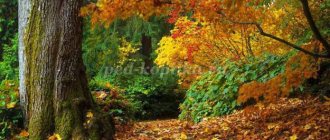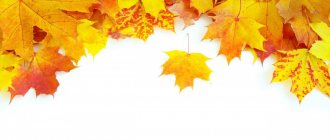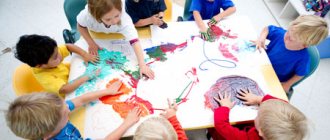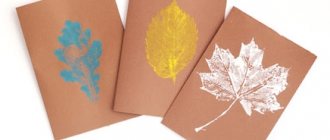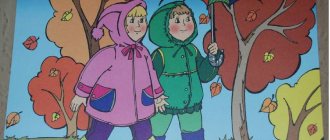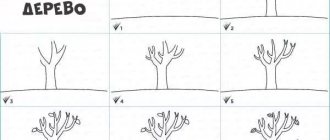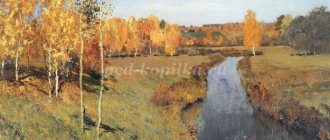Conversation with children of the senior group on the topic “Autumn”
Conversation with children of the senior group on the topic “Autumn”
Target:
consolidate children's knowledge about autumn changes in nature.
Objectives:
- teach children to convey in words the beauty of the observed nature in the autumn;
— develop communication skills; - cultivate the ability to admire native nature. Material:
text by G.A.
Skrebitsky “Autumn”, illustrations depicting autumn. Preliminary work:
memorizing poems about autumn, excursions to the autumn forest.
Vocabulary work:
golden brocade, lemon yellow, oak-hero, forged copper armor, fragrant haystack, haystacks, schools of migratory birds, aspen.
Move.
Educator.
Today, children, we will talk about golden autumn.
Now I suggest closing your eyes and imagining that we are in an autumn forest full of fairy tales and miracles. Now we will walk along the forest paths and listen to the leaves rustling under our feet. ( The sound recording starts - the rustling of leaves
).
Educator.
Why can you see so far in the forest now?
Child.
The trees are bare, only here and there there are leaves that fall with gusts of wind.
Educator.
What is your mood when you look at bare trees and dried grass?
(Children's answers). Educator.
Do you hear the roar and whistle of the wind?
(Children's answers). Educator.
Which poet loved autumn?
Child.
A. Pushkin, A. Pleshcheev.
Pleshcheev wrote a poem about autumn. Autumn has come, the flowers have dried up, and the bare bushes look sad. The grass in the meadows withers and turns yellow, Only the winter in the fields turns green. A cloud covers the sky, the sun does not shine, the wind howls in the field, the rain drizzles... The waters of the Fast stream rustled, the birds flew away to distant lands. Educator.
Poets have written many poems about autumn.
I want to read you a story about autumn. And this fabulous story was written by G.A. Skrebitsky. (Reading the story by G.A. Skrebitsky “Autumn”). ( Display of video material depicting autumn
)
Educator.
Where did the artist go in autumn?
Child.
Autumn has left the forest for fields and meadows.
She removed golden grain from the fields, and in the meadows she swept fragrant haystacks into haystacks as high as towers. Educator.
How did autumn cover the birches and maples?
Child.
Autumn covered the birches and maples with lemon yellow.
Educator.
What about aspen leaves?
Child.
The leaves of the aspen trees turned red, like ripe apples.
Educator.
What did the aspen tree become like?
Child.
The aspen tree became bright red, all burning like fire.
Educator.
What did autumn think to dress the oak tree in?
Child.
Standing in the middle of a clearing is a hundred-year-old oak tree, shaking its thick leaves.
Autumn thinks: “We need to dress the hero in forged copper armor.” This is how I dressed the old man. Educator.
How did autumn decorate the bushes and trees?
Child.
Autumn decorated all the trees and bushes in its own way, in an autumnal way: some were dressed in yellow, others were dressed in bright red.
Educator.
What has autumn done to the pines and spruces?
Child.
She only didn’t know how to decorate the pine and spruce trees. After all, they don’t have leaves on their branches, but needles; it won’t decorate them. Let them remain the same as they were in the summer.
Publication address:
Conversation on the topic “Autumn” in the preparatory group
Summary of a conversation about autumn in the preparatory group of a preschool educational institution
The summary of the conversation is aimed at expanding children's knowledge about the characteristic signs of autumn.
Conversation for children of the preparatory group. It can be used in working with children to consolidate and expand knowledge about autumn, the characteristic signs of autumn. Goal:
to expand children’s knowledge about the characteristic signs of autumn.
Objectives:
- to consolidate children’s knowledge about work in the fall;
- through artistic expression, to enrich children’s poetic world of nature, to develop their artistic taste; - to cultivate attention and love for native nature. Preliminary work:
observing nature on a walk; targeted walks in the forest; looking at illustrations in the album “Seasons”; memorizing poems. Material: paintings of autumn content, paintings depicting the work of people.
Progress of the lesson.
Educator.
What time of year is it now?
Remember and name the autumn months. (Children's answers). Educator.
Which month is called the magician of color and why?
Child.
September.
In September, autumn covers the birch and maple trees with lemon yellow, and the aspen leaves are colored as if they were ripe apples, the heroic oak is dressed in forged copper armor, and the linden tree is dressed in a heavy headdress made of gold brocade. Educator.
What was the weather like in September?
Child.
Warm, sunny.
The sky is bright blue. But the sun does not rise as high as in summer. Educator.
Remember the poem by the poet F. Tyutchev.
Child. In the original autumn there is a short but wonderful time - The whole day is as if crystalline and the evenings are radiant. The air is empty, the birds can no longer be heard, But the first winter storms are still far away, And clean and warm azure is pouring onto the resting field... Educator.
What phenomenon did we observe at the very beginning of September?
There is a riddle about it: “First there is a shine, after the shine there is a crackle, after the crackle there is a splash.” What is this? Child.
Storm.
Thunder in September foreshadows a warm autumn. Educator.
What is the name for the phenomenon when leaves fall from trees?
Child.
Leaf fall.
Leaves are falling and falling In our garden the leaves are falling Yellow and red leaves are curling and flying in the wind. Educator.
We were in the forest several times.
What is rich in the forest in early autumn? Child.
Mushrooms, berries.
Educator.
What mushrooms do you know?
Children.
Chanterelles, honey mushrooms, boletus, saffron milk caps, boletus, russula, etc.
Educator.
Maybe someone will remember a poem about the forest. A child reads a poem
I. Bunina “Falling Leaves”
The forest, like a painted tower, Lilac, golden, crimson, Stands like a cheerful, motley wall above a bright clearing, Birches with yellow carvings Shine in the blue azure. Like the towers, the Christmas trees darken, And between the maples they turn blue, Here and there, in the through foliage, There are gaps in the sky, like windows. The forest smells of oak and pine. Over the summer it has dried up from the sun, and autumn, like a quiet widow, enters its motley mansion. Educator.
What month of autumn does this poem figuratively and beautifully describe?
Child.
October.
Educator.
In October, autumn comes in full swing.
Tell us about the forest as you remember it in October. Child.
The forest is dark and gray.
All deciduous trees, except oak, stand without leaves. The foliage on the ground has already turned black and does not rustle underfoot. You can't hear the cheerful singing of birds. Educator.
How can you explain the proverb “In October, say goodbye to the sun, get closer to the stove.”
Child.
The sun appears less and less often, it is cold, pale, and does not warm.
What kind of rain does it rain in autumn? Child.
Small, boring, cold, lingering, drizzling.
Educator.
What changes have occurred on the river?
Child.
The water became cloudy and cold.
Fallen red, yellow, orange leaves float beautifully on the water like boats. Aquatic plants sink to the bottom. Frogs and snails burrow into the mud until spring. Fish gather in schools. Educator.
Why can't you hear birds singing already in October?
Child.
Birds fly south, where it is warm.
Educator.
Remember the poem
